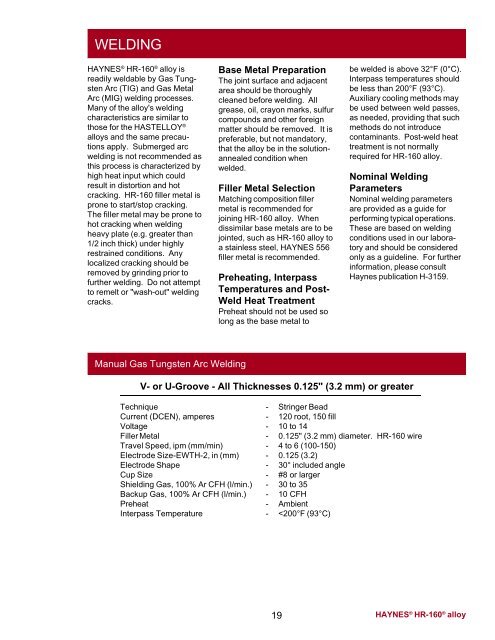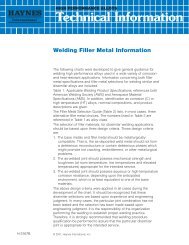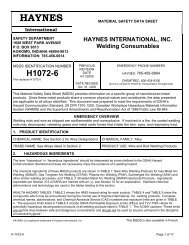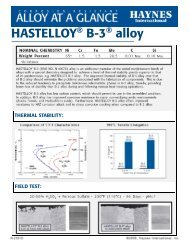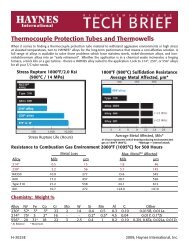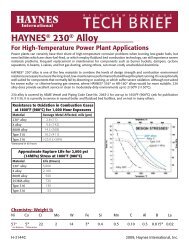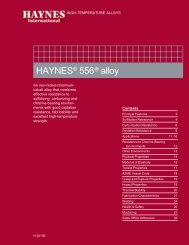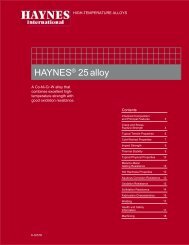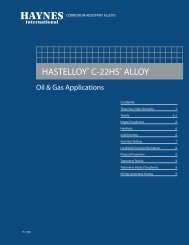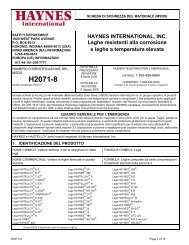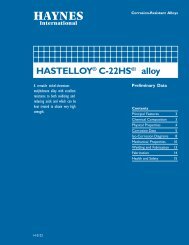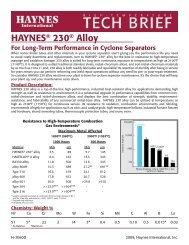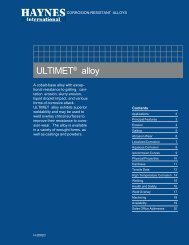HAYNES® HR-160® alloy - Haynes International, Inc.
HAYNES® HR-160® alloy - Haynes International, Inc.
HAYNES® HR-160® alloy - Haynes International, Inc.
You also want an ePaper? Increase the reach of your titles
YUMPU automatically turns print PDFs into web optimized ePapers that Google loves.
WELDING<br />
HAYNES ® <strong>HR</strong>-160 ® <strong>alloy</strong> is<br />
readily weldable by Gas Tungsten<br />
Arc (TIG) and Gas Metal<br />
Arc (MIG) welding processes.<br />
Many of the <strong>alloy</strong>'s welding<br />
characteristics are similar to<br />
those for the HASTELLOY ®<br />
<strong>alloy</strong>s and the same precautions<br />
apply. Submerged arc<br />
welding is not recommended as<br />
this process is characterized by<br />
high heat input which could<br />
result in distortion and hot<br />
cracking. <strong>HR</strong>-160 filler metal is<br />
prone to start/stop cracking.<br />
The filler metal may be prone to<br />
hot cracking when welding<br />
heavy plate (e.g. greater than<br />
1/2 inch thick) under highly<br />
restrained conditions. Any<br />
localized cracking should be<br />
removed by grinding prior to<br />
further welding. Do not attempt<br />
to remelt or "wash-out" welding<br />
cracks.<br />
Manual Gas Tungsten Arc Welding<br />
Base Metal Preparation<br />
The joint surface and adjacent<br />
area should be thoroughly<br />
cleaned before welding. All<br />
grease, oil, crayon marks, sulfur<br />
compounds and other foreign<br />
matter should be removed. It is<br />
preferable, but not mandatory,<br />
that the <strong>alloy</strong> be in the solutionannealed<br />
condition when<br />
welded.<br />
Filler Metal Selection<br />
Matching composition filler<br />
metal is recommended for<br />
joining <strong>HR</strong>-160 <strong>alloy</strong>. When<br />
dissimilar base metals are to be<br />
jointed, such as <strong>HR</strong>-160 <strong>alloy</strong> to<br />
a stainless steel, HAYNES 556<br />
filler metal is recommended.<br />
Preheating, Interpass<br />
Temperatures and Post-<br />
Weld Heat Treatment<br />
Preheat should not be used so<br />
long as the base metal to<br />
V- or U-Groove - All Thicknesses 0.125" (3.2 mm) or greater<br />
Technique - Stringer Bead<br />
Current (DCEN), amperes - 120 root, 150 fill<br />
Voltage - 10 to 14<br />
Filler Metal - 0.125" (3.2 mm) diameter. <strong>HR</strong>-160 wire<br />
Travel Speed, ipm (mm/min) - 4 to 6 (100-150)<br />
Electrode Size-EWTH-2, in (mm) - 0.125 (3.2)<br />
Electrode Shape - 30° included angle<br />
Cup Size - #8 or larger<br />
Shielding Gas, 100% Ar CFH (l/min.) - 30 to 35<br />
Backup Gas, 100% Ar CFH (l/min.) - 10 CFH<br />
Preheat - Ambient<br />
Interpass Temperature -


